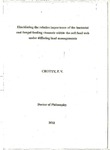Elucidating the relative importance of the bacterial and fungal feeding channels within the soil food web under differing land managements
| dc.contributor.supervisor | Blackshaw, Rod | |
| dc.contributor.author | Crotty, Felicity Victoria | |
| dc.contributor.other | Faculty of Science and Engineering | en_US |
| dc.date.accessioned | 2011-08-26T14:19:24Z | |
| dc.date.available | 2011-08-26T14:19:24Z | |
| dc.date.issued | 2011 | |
| dc.identifier | 10040479 | en_US |
| dc.identifier.uri | http://hdl.handle.net/10026.1/557 | |
| dc.description | Publications derived from this thesis: Crotty, F. V., Blackshaw, R. P., and Murray, P. J. (2011) Tracking the flow of bacterially derived 13C and 15N through soil faunal feeding channels. Rapid Communications in Mass Spectrometry 25: 1503-1513 (Chapter 5). Crotty, F. V., Blackshaw, R. P., and Murray, P. J. (2011) Differential growth of the fungus Absidia cylindrospora on 13C/15N labelled media. Rapid Communications in Mass Spectrometry 25: 1479-1484 (Chapter 7). Crotty F. V. First Prize in the Agriculture, Food, Diet and Health category in the BBSRC science photo competition (Feb-10). Featured in Science 327, (2010) p1183. Murray P. J., Clegg C. D., Crotty F. V., de la Fuente Martinez N., Williams J. K., & Blackshaw R. P. (2009) Dissipation of bacterially derived C and N through the meso- and macrofauna of a grassland soil. Soil Biology and Biochemistry 41:1146-1150 | en_US |
| dc.description.abstract |
The overall aim of this thesis was to elucidate the relative importance of the bacterial and fungal energy channels within the soil food web and to differentiate and appreciate the differences in niche of the soil fauna when affected by differing land management. Feeding niche of the soil fauna is ambiguous and has been previously determined by observation, inference or biochemical studies. One method that can determine feeding preferences in situ is the use of stable isotopes. Stable isotopes trace the passage of C and N through different trophic levels, both at natural abundance and by the addition of a pulse of enrichment. The work described within this thesis describes the development of methods of culturing and labelling organisms for use in stable isotope studies. Bacteria, protozoa and fungi were cultured with stable isotopes enriched to 99 atom% and their growth and survival monitored. Utilising stable isotope enriched organisms means that empirical testing of the feeding interactions can occur and that differences between the bacterial and fungal energy channels can be explored. Two field sites were chosen to assess how management changes affect the food web, both sites were historically grassland with the same soil type, but one was converted to a willow woodland twenty years ago. The results of these studies have shown, at natural abundance a grassland and woodland habitat with very different stable isotope signatures, reflecting plant and soil composition, as well as differences in trophic niche and C drivers. The introduction of enriched bacteria illustrated that bacterial feeding was more widespread than normally portrayed in food web diagrams. The introduction of enriched protozoa highlighted that protozoan feeding by soil fauna was more prevalent in the grassland habitat; reflecting differences in linkages between trophic levels within the two habitats. Methods were also developed to “grow” enriched fungal hyphae back into soil food webs in a comparable way to the investigation of the bacterial energy channel. Different species of saprotrophic fungi were found to fractionate to differing extents when grown on the same natural abundance media and the fungus Absidia cylindrospora's growth was impacted when grown on a dually enriched medium. We can now infer that the bacterial energy channel is not as divergent from the fungal energy channel as previously hypothesised. The majority of soil fauna were found to be omnivorous through empirical results, consuming bacteria and protozoa, even when they were considered to be fungal feeders by the literature. The different habitats within the study were found to have different C drivers, with roots and soil being the primary driver in the grassland whilst litter was in the woodland, consequently favouring different food webs. This work makes a first step in measuring the contribution of the different feeding channels and feeding interactions occurring within the different trophic levels in the two habitats and shows the effect that one change in management has had over the entire faunal assemblage. | en_US |
| dc.description.sponsorship | BBSRC Rothamsted Research (North Wyke) | en_US |
| dc.language.iso | en | en_US |
| dc.publisher | University of Plymouth | en_US |
| dc.subject | Food webs | en_US |
| dc.subject | Trophic transfers | en_US |
| dc.subject | Feeding preferences | en_US |
| dc.subject | Mesofauna | en_US |
| dc.subject | Collembola | en_US |
| dc.subject | Acari | en_US |
| dc.subject | Stable isotopes | en_US |
| dc.title | Elucidating the relative importance of the bacterial and fungal feeding channels within the soil food web under differing land managements | en_US |
| dc.type | Thesis | |
| dc.identifier.doi | http://dx.doi.org/10.24382/3839 |
Files in this item
This item appears in the following Collection(s)
-
01 Research Theses Main Collection
Research Theses Main


